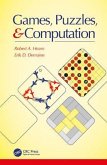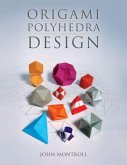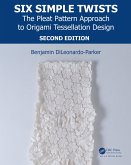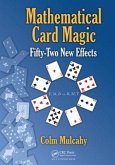Origami 5
Fifth International Meeting of Origami Science, Mathematics, and Education
Herausgeber: Wang-Iverson, Patsy; Yim, Mark; Lang, Robert J.
Origami 5
Fifth International Meeting of Origami Science, Mathematics, and Education
Herausgeber: Wang-Iverson, Patsy; Yim, Mark; Lang, Robert J.
- Broschiertes Buch
- Merkliste
- Auf die Merkliste
- Bewerten Bewerten
- Teilen
- Produkt teilen
- Produkterinnerung
- Produkterinnerung
"While many individuals have discovered discrete connections among origami, mathematics, science, technology, and education during the twentieth century, the field really took off when previously isolated individuals began to make stronger connections with each other, exploring the links between origami and "the outside world." This volume brings together an unprecedented number of researchers who discuss topics ranging from mathematics to technology to educational uses of origami to fine art to computerprograms for the design of origami"--
Andere Kunden interessierten sich auch für
![Games, Puzzles, and Computation Games, Puzzles, and Computation]() Robert A. HearnGames, Puzzles, and Computation148,99 €
Robert A. HearnGames, Puzzles, and Computation148,99 €![Origami Polyhedra Design Origami Polyhedra Design]() John MontrollOrigami Polyhedra Design44,99 €
John MontrollOrigami Polyhedra Design44,99 €![Curved-Folding Origami Design Curved-Folding Origami Design]() Jun Mitani (Japan University of Tsukuba)Curved-Folding Origami Design58,99 €
Jun Mitani (Japan University of Tsukuba)Curved-Folding Origami Design58,99 €![Six Simple Twists Six Simple Twists]() Benjamin DiLeonardo-ParkerSix Simple Twists47,99 €
Benjamin DiLeonardo-ParkerSix Simple Twists47,99 €![Crafting Conundrums Crafting Conundrums]() Ellie BakerCrafting Conundrums52,99 €
Ellie BakerCrafting Conundrums52,99 €![Mathematical Card Magic Mathematical Card Magic]() Colm Mulcahy (USA Spelman College)Mathematical Card Magic50,99 €
Colm Mulcahy (USA Spelman College)Mathematical Card Magic50,99 €![Ornamental Origami Ornamental Origami]() Meenakshi MukerjiOrnamental Origami34,99 €
Meenakshi MukerjiOrnamental Origami34,99 €-
-
-
"While many individuals have discovered discrete connections among origami, mathematics, science, technology, and education during the twentieth century, the field really took off when previously isolated individuals began to make stronger connections with each other, exploring the links between origami and "the outside world." This volume brings together an unprecedented number of researchers who discuss topics ranging from mathematics to technology to educational uses of origami to fine art to computerprograms for the design of origami"--
Produktdetails
- Produktdetails
- AK Peters/CRC Recreational Mathematics Series
- Verlag: Taylor & Francis Inc
- Seitenzahl: 670
- Erscheinungstermin: 21. Juni 2011
- Englisch
- Abmessung: 229mm x 152mm x 36mm
- Gewicht: 962g
- ISBN-13: 9781568817149
- ISBN-10: 1568817142
- Artikelnr.: 32420567
- Herstellerkennzeichnung
- Libri GmbH
- Europaallee 1
- 36244 Bad Hersfeld
- gpsr@libri.de
- AK Peters/CRC Recreational Mathematics Series
- Verlag: Taylor & Francis Inc
- Seitenzahl: 670
- Erscheinungstermin: 21. Juni 2011
- Englisch
- Abmessung: 229mm x 152mm x 36mm
- Gewicht: 962g
- ISBN-13: 9781568817149
- ISBN-10: 1568817142
- Artikelnr.: 32420567
- Herstellerkennzeichnung
- Libri GmbH
- Europaallee 1
- 36244 Bad Hersfeld
- gpsr@libri.de
Patsy Wang-Iverson is Vice President for Special Projects at the Gabriella and Paul Rosenbaum Foundation. Introduced to origami as a child by her mother, her personal interest in origami merged in recent years with her work in helping to improve students' interest in and success with mathematics. She co-organized, with Eileen Tan and Benjamin Tan, the 2010 Fifth International Meeting on Origami in Science, Mathematics and Education (5OSME) plus a Folding Convention (PLUS!) at the Singapore Management University in Singapore. Robert J. Lang has been an avid student of origami for some forty years and is now recognized as one of the world's leading masters of the art. He is one of the pioneers of the cross-disciplinary marriage of origami with mathematics and organized the 2006 Fourth International Meeting on Origami in Science, Mathematics, and Education at Caltech. He has consulted on applications of origami to medical devices, air-bag design, and space telescopes, is the author or co-author of twelve books and numerous articles on origami and lectures widely on the connections between origami, mathematics, science, and technology.Mark Yim is a professor of mechanical engineering at the University of Pennsylvania. Previously, he was a Principal Scientist at the Palo Alto Research Center (formerly Xerox PARC). His group studies modular self-reconfigurable robots and has demonstrated robots that can transform into different shapes, jump, ride tricycles, climb stairs, poles and fences, manipulate objects and reassemble themselves. Collaborative work with researchers at Harvard, MIT and Berkeley include robotic self-folding origami. He has authored over 100 journal and conference papers and over 40 patents on topics ranging from robotics and videogame feedback devices to education and robotic performance art.
Origami History, Art, and Design: History of Origami in the East and the
West before InterfusionDeictic Properties of Origami Technical Terms and
Translatability. Betsy Ross Revisited: General Fold and One-Cut Regular and
Star Polygons. Reconstructing David Huffman's Legacy in Curved-Crease
Folding. Simulation of Nonzero Gaussian Curvature in Origami by
Curved-Crease Couplets. Compression and Rotational Limitations of Curved
Corrugations. Polygon Symmetry Systems. New Collaboration on Modular
Origami and LED. Using the Snapology Technique to Teach Convex Polyhedra. A
Systematic Approach to Twirl Design. Oribotics: The Future Unfolds. Origami
in Education: Origametria and the van Hiele Theory of Teaching Geometry.
Student-Teachers Introduce Origami in Kindergarten and Primary Schools.
Narratives of Success: Teaching Origami in Low-Income Urban Communities.
Origami and Spatial Thinking of College-Age Students. Close Observation and
Reverse Engineering of Origami Models. Origami and Learning Mathematics.
Hands-On Geometry with Origami. .My Favorite Origamics Lessons on the
Volume of Solids. Origami Science, Engineering, and Technology:
Rigid-Foldable Thick Origami. Folding a Patterned Cylinder by Rigid
Origami. The Origami Crash Box. Origami Folding: A Structural Engineering
Approach. Designing Technical Tessellations. A Simulator for
Origami-Inspired Self-Reconfigurable Robots. A CAD System for Diagramming
Origami with Prediction of Folding Processes. Development of an Intuitive
Algorithm for Diagramming and 3D Animated. Hands-Free Microscale Origami.
Foldable Parylene Origami Sheets Covered with Cells: Toward
Applications...Mathematics of Origami: Introduction to the Study of Tape
Knots. Universal Hinge Patterns for Folding Orthogonal Shapes. A General
Method of Drawing Biplanar Crease Patterns. A Design Method for
Axisymmetric Curved Origami with Triangular Prism Protrusions. Folding Any
Orthogonal Maze. Every Spider Web Has a Simple Flat Twist Tessellation.
Flat-Unfoldability and Woven Origami Tessellations. Degenerative
Coordinates in 22.5° Grid System. Two Folding Constructions. Variations on
a Theorem of Haga. Precise Division of Rectangular Paper into an Odd Number
of Equal Parts. The Speed of Origami Constructions Versus Other
Construction Tools. A Note on Operations of Spherical Origami Construction.
Origami Alignments and Constructions in the Hyperbolic Plane. A
Combinatorial Definition of 3D Flat-Folding. Stamp Foldings with a Given
Mountain-Valley Assignment. Flat Vertex Fold Sequences. Circle Packing for
Origami Design Is Hard.
West before InterfusionDeictic Properties of Origami Technical Terms and
Translatability. Betsy Ross Revisited: General Fold and One-Cut Regular and
Star Polygons. Reconstructing David Huffman's Legacy in Curved-Crease
Folding. Simulation of Nonzero Gaussian Curvature in Origami by
Curved-Crease Couplets. Compression and Rotational Limitations of Curved
Corrugations. Polygon Symmetry Systems. New Collaboration on Modular
Origami and LED. Using the Snapology Technique to Teach Convex Polyhedra. A
Systematic Approach to Twirl Design. Oribotics: The Future Unfolds. Origami
in Education: Origametria and the van Hiele Theory of Teaching Geometry.
Student-Teachers Introduce Origami in Kindergarten and Primary Schools.
Narratives of Success: Teaching Origami in Low-Income Urban Communities.
Origami and Spatial Thinking of College-Age Students. Close Observation and
Reverse Engineering of Origami Models. Origami and Learning Mathematics.
Hands-On Geometry with Origami. .My Favorite Origamics Lessons on the
Volume of Solids. Origami Science, Engineering, and Technology:
Rigid-Foldable Thick Origami. Folding a Patterned Cylinder by Rigid
Origami. The Origami Crash Box. Origami Folding: A Structural Engineering
Approach. Designing Technical Tessellations. A Simulator for
Origami-Inspired Self-Reconfigurable Robots. A CAD System for Diagramming
Origami with Prediction of Folding Processes. Development of an Intuitive
Algorithm for Diagramming and 3D Animated. Hands-Free Microscale Origami.
Foldable Parylene Origami Sheets Covered with Cells: Toward
Applications...Mathematics of Origami: Introduction to the Study of Tape
Knots. Universal Hinge Patterns for Folding Orthogonal Shapes. A General
Method of Drawing Biplanar Crease Patterns. A Design Method for
Axisymmetric Curved Origami with Triangular Prism Protrusions. Folding Any
Orthogonal Maze. Every Spider Web Has a Simple Flat Twist Tessellation.
Flat-Unfoldability and Woven Origami Tessellations. Degenerative
Coordinates in 22.5° Grid System. Two Folding Constructions. Variations on
a Theorem of Haga. Precise Division of Rectangular Paper into an Odd Number
of Equal Parts. The Speed of Origami Constructions Versus Other
Construction Tools. A Note on Operations of Spherical Origami Construction.
Origami Alignments and Constructions in the Hyperbolic Plane. A
Combinatorial Definition of 3D Flat-Folding. Stamp Foldings with a Given
Mountain-Valley Assignment. Flat Vertex Fold Sequences. Circle Packing for
Origami Design Is Hard.
Origami History, Art, and Design: History of Origami in the East and the
West before InterfusionDeictic Properties of Origami Technical Terms and
Translatability. Betsy Ross Revisited: General Fold and One-Cut Regular and
Star Polygons. Reconstructing David Huffman's Legacy in Curved-Crease
Folding. Simulation of Nonzero Gaussian Curvature in Origami by
Curved-Crease Couplets. Compression and Rotational Limitations of Curved
Corrugations. Polygon Symmetry Systems. New Collaboration on Modular
Origami and LED. Using the Snapology Technique to Teach Convex Polyhedra. A
Systematic Approach to Twirl Design. Oribotics: The Future Unfolds. Origami
in Education: Origametria and the van Hiele Theory of Teaching Geometry.
Student-Teachers Introduce Origami in Kindergarten and Primary Schools.
Narratives of Success: Teaching Origami in Low-Income Urban Communities.
Origami and Spatial Thinking of College-Age Students. Close Observation and
Reverse Engineering of Origami Models. Origami and Learning Mathematics.
Hands-On Geometry with Origami. .My Favorite Origamics Lessons on the
Volume of Solids. Origami Science, Engineering, and Technology:
Rigid-Foldable Thick Origami. Folding a Patterned Cylinder by Rigid
Origami. The Origami Crash Box. Origami Folding: A Structural Engineering
Approach. Designing Technical Tessellations. A Simulator for
Origami-Inspired Self-Reconfigurable Robots. A CAD System for Diagramming
Origami with Prediction of Folding Processes. Development of an Intuitive
Algorithm for Diagramming and 3D Animated. Hands-Free Microscale Origami.
Foldable Parylene Origami Sheets Covered with Cells: Toward
Applications...Mathematics of Origami: Introduction to the Study of Tape
Knots. Universal Hinge Patterns for Folding Orthogonal Shapes. A General
Method of Drawing Biplanar Crease Patterns. A Design Method for
Axisymmetric Curved Origami with Triangular Prism Protrusions. Folding Any
Orthogonal Maze. Every Spider Web Has a Simple Flat Twist Tessellation.
Flat-Unfoldability and Woven Origami Tessellations. Degenerative
Coordinates in 22.5° Grid System. Two Folding Constructions. Variations on
a Theorem of Haga. Precise Division of Rectangular Paper into an Odd Number
of Equal Parts. The Speed of Origami Constructions Versus Other
Construction Tools. A Note on Operations of Spherical Origami Construction.
Origami Alignments and Constructions in the Hyperbolic Plane. A
Combinatorial Definition of 3D Flat-Folding. Stamp Foldings with a Given
Mountain-Valley Assignment. Flat Vertex Fold Sequences. Circle Packing for
Origami Design Is Hard.
West before InterfusionDeictic Properties of Origami Technical Terms and
Translatability. Betsy Ross Revisited: General Fold and One-Cut Regular and
Star Polygons. Reconstructing David Huffman's Legacy in Curved-Crease
Folding. Simulation of Nonzero Gaussian Curvature in Origami by
Curved-Crease Couplets. Compression and Rotational Limitations of Curved
Corrugations. Polygon Symmetry Systems. New Collaboration on Modular
Origami and LED. Using the Snapology Technique to Teach Convex Polyhedra. A
Systematic Approach to Twirl Design. Oribotics: The Future Unfolds. Origami
in Education: Origametria and the van Hiele Theory of Teaching Geometry.
Student-Teachers Introduce Origami in Kindergarten and Primary Schools.
Narratives of Success: Teaching Origami in Low-Income Urban Communities.
Origami and Spatial Thinking of College-Age Students. Close Observation and
Reverse Engineering of Origami Models. Origami and Learning Mathematics.
Hands-On Geometry with Origami. .My Favorite Origamics Lessons on the
Volume of Solids. Origami Science, Engineering, and Technology:
Rigid-Foldable Thick Origami. Folding a Patterned Cylinder by Rigid
Origami. The Origami Crash Box. Origami Folding: A Structural Engineering
Approach. Designing Technical Tessellations. A Simulator for
Origami-Inspired Self-Reconfigurable Robots. A CAD System for Diagramming
Origami with Prediction of Folding Processes. Development of an Intuitive
Algorithm for Diagramming and 3D Animated. Hands-Free Microscale Origami.
Foldable Parylene Origami Sheets Covered with Cells: Toward
Applications...Mathematics of Origami: Introduction to the Study of Tape
Knots. Universal Hinge Patterns for Folding Orthogonal Shapes. A General
Method of Drawing Biplanar Crease Patterns. A Design Method for
Axisymmetric Curved Origami with Triangular Prism Protrusions. Folding Any
Orthogonal Maze. Every Spider Web Has a Simple Flat Twist Tessellation.
Flat-Unfoldability and Woven Origami Tessellations. Degenerative
Coordinates in 22.5° Grid System. Two Folding Constructions. Variations on
a Theorem of Haga. Precise Division of Rectangular Paper into an Odd Number
of Equal Parts. The Speed of Origami Constructions Versus Other
Construction Tools. A Note on Operations of Spherical Origami Construction.
Origami Alignments and Constructions in the Hyperbolic Plane. A
Combinatorial Definition of 3D Flat-Folding. Stamp Foldings with a Given
Mountain-Valley Assignment. Flat Vertex Fold Sequences. Circle Packing for
Origami Design Is Hard.









